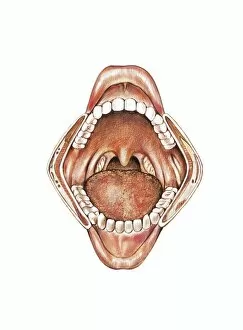Human Mouth Collection (page 4)
The human mouth is a fascinating organ that serves multiple purposes
All Professionally Made to Order for Quick Shipping
The human mouth is a fascinating organ that serves multiple purposes. It not only allows us to communicate through speech but also plays a crucial role in our sense of taste and the process of digestion. Did you know that the tongue has different areas sensitive to various tastes? According to the taste map, the light green area on your tongue is particularly sensitive to bitter tastes, while yellow areas detect sour tastes. The blue regions are responsible for sensing saltiness, and the purple area is where sweet flavors are detected. This intricate system helps us savor and differentiate between various flavors. When we examine the anatomy of the mouth, we can see its complexity. From an engraving depicting organs, we observe how it connects with other vital systems like respiration and digestion. The cross-section diagram showcases both our oral cavity and jaw structure, highlighting their interdependence. Speaking of which, let's not forget about teeth. A maxilla bone illustration shows how these essential tools for chewing are anchored within our mouths. They play a significant role in breaking down food before it enters our digestive system. Furthermore, understanding respiratory functions is crucial when studying the human mouth cavity. An illustration displaying nasal cavities, larynx, trachea, bronchus, and lungs demonstrates how air passes through this pathway during breathing. Now let's focus solely on one aspect: the tongue itself. A front view diagram reveals its anatomical details—taste buds covering its surface enable us to perceive different flavors accurately. Moving beyond scientific depictions into artistry; a traditional Japanese woodblock print captures an actor's expressive face—an embodiment of emotions conveyed through facial features including lips that shape words or express feelings such as pouting or crying—a testament to how much power lies within this small part of our body. Lastly, exploring medical illustrations from centuries ago reminds us of historical knowledge gained about facial nerves' intricacies related to sensation around our mouths—a reminder that even long ago, humans were fascinated by this remarkable organ.














